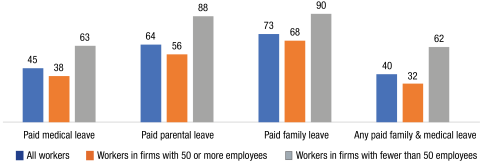Key Findings


Twenty years of research establishes the numerous health and economic benefits for families and for businesses with paid family and medical leave. In states without universal paid leave programs, workers’ access to paid leave depends on whether one’s employer includes it as a workplace benefit. The result is vastly uneven access. According to Granite State Poll data collected in December 2022, just under one half of New Hampshire workers lack access to paid leave to tend to their own illness, about two-thirds lack access to parental leave to care for a new child, and about three-fourths lack access to care for an ill family member (Figure 1). Stark differences in access to paid leave exist depending on whether one works for a smaller employer (one with fewer than 50 employees) or a larger one (50 employees or more). Employees working in small firms more often lack access (Figure 1). Women also have lower access to paid leave than men—53 percent of women lack access to paid medical leave compared with 32 percent of men and 80 percent of women lack access to parental leave compared with 48 percent of men.
In January 2023, New Hampshire launched its voluntary Paid Family and Medical Leave program administered through a private insurance company. Just prior to launch, 17 percent of workers had heard about the new program, with public sector workers more likely to know of the program than private (68 percent compared with just 10 percent, respectively). In the first year of the program, program administrative data shows that 8,862 workers were automatically enrolled in the program as state employees, and 5,372 employees benefitted when their firms opted-in; 478 employees also opted-in as individual workers. In total, the program has reached 14,712 workers or less than 3 percent of Granite State workers.
Figure 1. Percent of NH Workers Without Access to Paid Leave, by Leave Type and Firm Size, December 2022

Note: N=372 employed residents. Estimates are weighted. Relationship between access to paid medical, parental, and family leave and firm size is statistically significant (p<0.001, two-tailed test). Source: Granite State Poll, Paid Family & Medical Leave Topical Module, 2022.
In addition to a lack of awareness, low enrollment may be linked to NH Paid Family and Medical Leave Program components. For instance, the program does not include job protection other than what is offered in the Family and Medical Leave Act (FMLA). This may be a barrier to program participation, since workers with access to leave without job protection have lower usage rates. The short length of leave provided by the program (six weeks) may also be a barrier, as under half of workers believe six weeks is about the right amount. If state policymakers intend to increase access to, and decrease inequity in, paid family and medical leave, they could consider including job protection and increasing the length of leave offered by the program.
Endnotes
- Byker, Tanya and Elena Patel. 2021. “A Proposal for a Federal Paid Parental and Medical Leave Program.” The Hamilton Project, Brookings Institution, Washington, DC; National Partnership for Women & Families, Factsheet. 2023. “Paid Leave Works: Evidence from State Programs.” Washington, DC.
- Email communication with the NH Paid Family and Medical Leave Program, NH Department of Administrative Services, February 2, 2024.
- In terms of job protection, the NH Paid Family and Medical Leave program follows the Family and Medical Leave Act (FMLA), which provides job protection for workers in firms with 50 or more employees who have worked at least 1,250 hours in the past 12 months for the same employer. In January 2023, 95.6% of New Hampshire firms employed less than 50 employees (representing 36.5% of workers in the state), rendering employees in those firms ineligible for mandated job protection. (See Preliminary First Quarter 2023, NH Firms by Size.)
- Smith, Kristin. 2019. “Job Replacement and Wage Replacement: Key Factors in Take Up of Paid Family and Medical Leave Among Lower-Wage Workers.” National Issue Brief # 141 (Durham, NH: Carsey School of Public Policy).
- Thirty-six percent believe six weeks is about the right amount, 29 percent believe six weeks is too low, 9 percent believe six weeks is too high, and 26 percent are unsure or don’t know, according to author analysis of the December 2022 Granite State Poll.
Data
This analysis is based on Granite State Poll (GSP) data collected by the University of New Hampshire, Survey Center in December 2022. The author developed a Paid Leave Topical Module that was added to the GSP. Workers in this brief include those working full- and part-time. All estimates are weighted and statistical comparisons in the text are statistically significant at p<0.05.
About the Author
Kristin Smith is a visiting research associate professor of sociology and Director of the Policy Research Shop at the Rockefeller Center at Dartmouth College, and senior fellow at the Carsey School of Public Policy, University of New Hampshire. Smith’s research focuses on gender inequality, earnings and employment, and work and family policy.
Acknowledgements
Data collection on the Granite State Poll was funded by the Rockefeller Center, Dartmouth College. Dartmouth undergraduate student, Jessica Li, provided research assistance.
